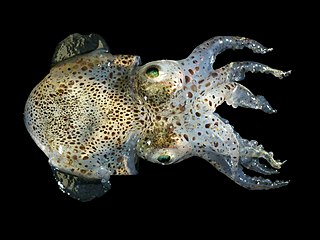Related Research Articles

Bobtail squid are a group of cephalopods closely related to cuttlefish. Bobtail squid tend to have a rounder mantle than cuttlefish and have no cuttlebone. They have eight suckered arms and two tentacles and are generally quite small.

Euprymna tasmanica, also known as the southern dumpling squid or southern bobtail squid, is a bobtail squid that lives in the shallow temperate coastal waters of southern Australia's continental shelf. It lives for between 5 and 8 months and the adults can grow up to 6 or 7 cm long with a mantle length of 3 to 4 cm. They are found in seagrass beds or areas with soft silty or muddy bottoms from Brisbane on the east coast to Shark Bay on the west, as well as around Tasmania. Southern dumpling squid are nocturnal and during the day hide in sand or mud covered in a mucus-lined coat of sediment. If disturbed acid glans can quickly remove this coat as an additional decoy to ink squirting.

Sepia mestus, also known as the reaper cuttlefish or red cuttlefish, is a species of cuttlefish native to the southwestern Pacific Ocean, specifically Escape Reef off Queensland to Murrays Beach off Jervis Bay. Reports of this species from China and Vietnam are now known to be misidentifications. S. mestus lives at a depth of between 0 and 22 m.

Cephalopod ink is a dark-coloured or luminous ink released into water by most species of cephalopod, usually as an escape mechanism. All cephalopods, with the exception of the Nautilidae and the Cirrina, are able to release ink.

Cuttlefish or cuttles are marine molluscs of the order Sepiida. They belong to the class Cephalopoda, which also includes squid, octopuses, and nautiluses. Cuttlefish have a unique internal shell, the cuttlebone, which is used for control of buoyancy.

Peripatopsidae is one of the two living velvet worm families.

Cephalopods, specifically pertaining to octopuses, squids, nautiluses and cuttlefishes, are most commonly represented in popular culture in the Western world as creatures that spray ink and latch onto things with their tentacles without releasing.
Aethrikos is a monospecific genus of velvet worm containing the single species Aethrikos setosa. It is found in New South Wales, Australia.
Leuropezos is a monospecific genus of velvet worm containing the single species Leuropezos eungellensis. It is found in Queensland, Australia.
Hylonomoipos is a genus of velvet worm in the Peripatopsidae family. They are found in Queensland, Australia.
Nodocapitus is a genus of velvet worm in the Peripatopsidae family. N. formosus is found in Queensland, Australia, N. inornatus is found in New South Wales, and N. barryi is found in both of these states.

Louise Allcock is a British researcher, best known for her work on ecology and evolution of the cephalopods of the Southern Ocean and deep sea. She is the editor of the Zoological Journal of the Linnean Society.
Hylonomoipos brookensis is a species of velvet worm in the Peripatopsidae family. It is found in Queensland, Australia.
Nodocapitus barryi is a species of velvet worm in the Peripatopsidae family. It is found in Queensland and New South Wales, Australia.
Nodocapitus formosus is a species of velvet worm in the Peripatopsidae family. It is found in Queensland, Australia.
Ruhbergia bifalcata is a species of velvet worm in the family Peripatopsidae. The type locality is in New South Wales, Australia.
Ruhbergia brevicorna is a species of velvet worm in the Peripatopsidae family. The type locality is in New South Wales, Australia.
Ruhbergia rostroides is a species of velvet worm in the Peripatopsidae family. The type locality is in New South Wales, Australia.
Ooperipatellus duwilensis is a species of velvet worm in the Peripatopsidae family. It is found in Victoria, Australia.
Ooperipatellus parvus is a species of velvet worm in the Peripatopsidae family. It is found in South Australia.
References
| Wikispecies has information related to Amanda Reid (malacologist) . |
- ↑ Reid, Amanda Louise (1990), Taxonomic review of the Australian Rossiinae (Cephalopoda : Sepiolidae) , retrieved 13 October 2020
- ↑ Reid, Amanda Louise (1996), A systematic review of the Peripatopsidae (Onychophora) in Australia , retrieved 13 October 2020
- ↑ "A Guide to Squid, Cuttlefish and Octopuses of Australasia | Gould League". gould.org.au. Archived from the original on 2016-03-05. Retrieved 2016-05-01.
- ↑ "Publications to 2010" (PDF). Australian Museum. Retrieved 2016-05-01.
- ↑ https://www.uow.edu.au/content/groups/public/@web/@health/documents/doc/uow056685.pdf
- ↑ "Mandy Reid - Australian Museum". australianmuseum.net.au. Retrieved 2016-05-01.